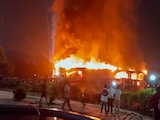Climate change is no longer a future issue but a defining reality of our time. Human activities such as the burning of fossil fuels, deforestation, and accelerated industrialisation have severely disrupted Earth's natural equilibrium. These processes release greenhouse gases that trap heat in the atmosphere, steadily warming the planet. As a result, we are witnessing a rise in extreme weather events-hurricanes, droughts, heatwaves, and erratic rainfall patterns-that are becoming increasingly frequent and severe.
The year 2024 served as a stark reminder of this transformation. NASA confirmed it as the hottest year on record, with global temperatures exceeding the 20th-century average by more than 1.3°C. Atmospheric carbon dioxide levels have surged to 420 parts per million, up from 278 ppm in 1750. The oceans have absorbed much of this excess heat, resulting in thermal expansion and rising sea levels, while polar ice caps continue to melt at unprecedented rates. Sea ice around Antarctica fell to near-historic lows, and glaciers across the globe persist in their rapid retreat. UNESCO reports that over 9,000 gigatonnes of ice have melted since 1975, affecting sea levels and freshwater reserves worldwide.
Beyond these visible impacts lies an even more complex threat: climate feedback loops. These are self-reinforcing mechanisms which, once triggered, amplify the effects of climate change and make them increasingly irreversible. Some of the most significant feedback loops include:
- Ice-Albedo Feedback: As ice and snow melt, darker ocean and land surfaces are exposed, absorbing more solar radiation and leading to further melting. This process could significantly reduce Earth's albedo (reflectivity). Some projections suggest the Arctic may experience ice-free summers as early as 2030.
- Permafrost Thawing: Rising temperatures are thawing permafrost-frozen ground that stores vast amounts of methane. Its release further accelerates warming, particularly in vulnerable regions such as Siberia.
- Water Vapour Feedback: Warmer air holds more moisture, increasing water vapour levels-a potent greenhouse gas. This intensifies the warming cycle by trapping even more heat.
- Forest Fires and Dieback: Increasing temperatures and shifting rainfall patterns are fuelling more frequent and intense wildfires. As forests burn and trees die, their ability to absorb carbon declines, adding more carbon dioxide to the atmosphere. Some areas of the Amazon, once a vital carbon sink, are now net carbon emitters.
- Ocean Heat Absorption Feedback: Warmer oceans are less capable of absorbing carbon dioxide, which exacerbates the greenhouse effect and further increases global temperatures.
- Ocean Stratification Feedback: As surface waters warm, they become more stratified, reducing vertical mixing with cooler, nutrient-rich layers. This weakens marine ecosystems and disrupts carbon cycling.
- Drought and Wildfire Feedback: Prolonged droughts kill off vegetation, making wildfires more likely and more intense. These fires release large volumes of carbon and destroy natural carbon sinks, further fuelling the climate crisis.
- Soil Carbon Release Feedback: As soil temperatures rise, carbon stored in the soil is released into the atmosphere, reducing fertility and contributing to greenhouse gas emissions.
- Ice Sheet Instability Feedback: The destabilisation of ice sheets is an increasing concern. Melting glaciers discharge vast amounts of freshwater into the oceans, potentially disrupting major currents such as the Atlantic Meridional Overturning Circulation (AMOC). This could destabilise global climate patterns and lead to further ice loss, creating a reinforcing cycle of warming.
These feedback loops are interconnected, each amplifying the next, and driving the climate towards tipping points that may become impossible to reverse.
What is the Solution?
While policy reform and technological innovation are critical, they are not sufficient on their own. The environmental crisis reveals a deeper imbalance. As Vedanta teaches, outer disharmony is often a reflection of inner disconnection.
In our pursuit of material progress, we may have overlooked the need for a deeper alignment with ourselves and with the natural world. True change may not come solely through policy or innovation, but through a fundamental re-evaluation of how we live and relate to nature.
As the Bhagavad Gita reminds us, right action draws its strength from self-awareness. To effectively respond to the climate crisis, both understanding and right action are essential.
We may be approaching, or have already neared, a tipping point. The dynamics we have set in motion make change all the more urgent. Yet there is still room-though limited-for meaningful and effective intervention.
(Acharya Prashant, a modern Vedanta exegete and philosopher, is a national bestselling author, columnist, and founder of the PrashantAdvait Foundation. An IIT-IIM alumnus, he is a recipient of the OCND Award from the IIT Delhi Alumni Association for outstanding contribution to national development.)
Disclaimer: These are the personal opinions of the author















